The conditions for the below application curves
are VIN = 3.6 V, VOUT = 1.2 V, and the components listed in
Table 9-1, unless otherwise noted.
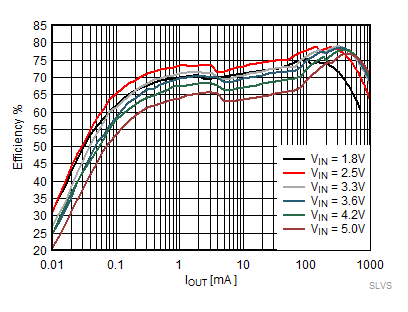
| TPS62800 | RVSEL = 10 kΩ to GND |
VOUT = 0.4 V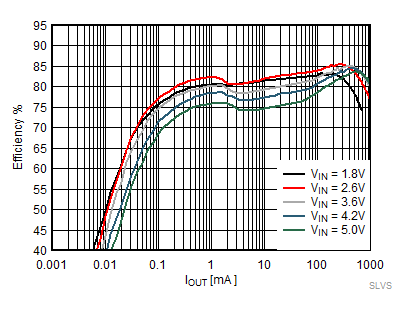
| TPS62801 | RVSEL = 10 kΩ to GND |
VOUT = 0.8 V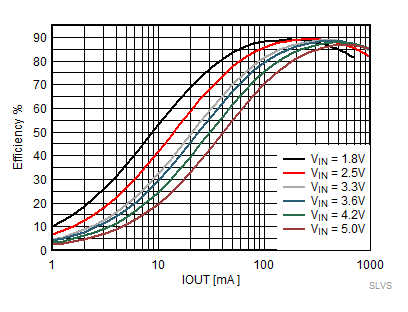
| TPS62801 | RVSEL = 56.2 kΩ |
| VSEL/MODE pin = high after start-up |
VOUT = 1.2 V
| TPS62801 | VSEL/MODE = GND, VOUT = 1.2
V |
| |
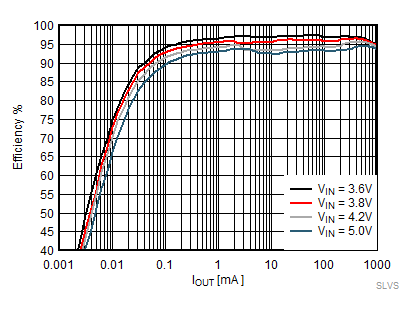
| TPS62802 | 3.3 V VOUT, VSEL/MODE = 249
k |
VOUT = 3.3 V
| TPS62807 | VOUT = 1.2 V, VSEL/MODE =
GND |
| L = 1-µH DFE201610E |
VOUT = 1.2 V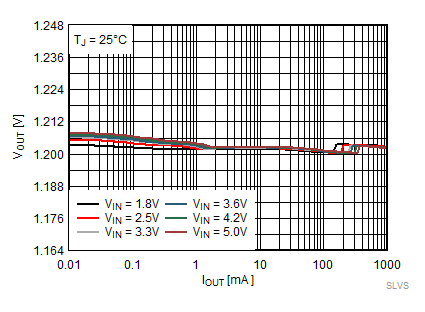
| TPS62801 | VSEL/MODE = GND |
| VOUT = 1.2 V | PFM/PWM mode | TJ = 25°C |

| TPS62801 | VSEL/MODE = GND |
| VOUT = 1.2 V | PFM/PWM mode | TJ = 85°C |
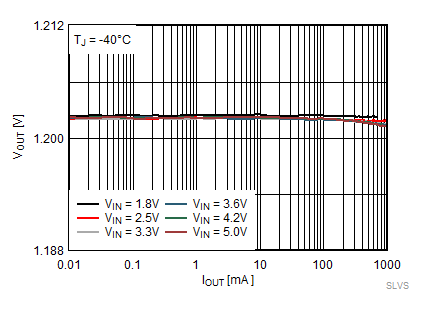
| TPS62801 | VSEL/MODE = high after start-up |
| VOUT = 1.2 V | Forced PWM mode | TJ = –40°C |
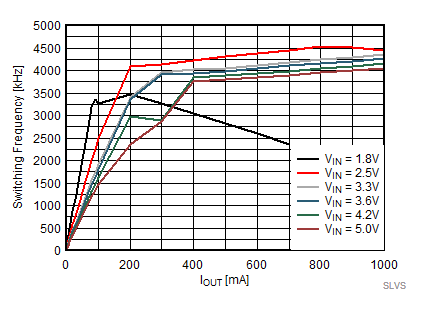
| TPS62801 | VSEL/MODE = GND |
| VOUT = 1.2 V | PFM/PWM mode | TJ = 25°C |

| TPS62801 | VSEL/MODE = high after start-up |
| VOUT = 1.2 V | Forced PWM Mode | TJ = 25°C |

| TPS62806 |
VSEL/MODE =
GND |
L = 1
µH |
| VOUT = 0.7
V |
PFM/PWM mode |
TJ = 25°C |
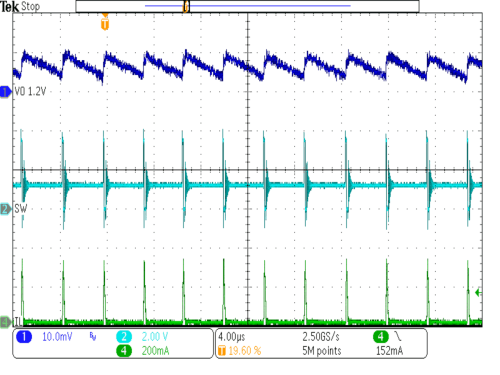
| TPS62801 |
VOUT = 1.2
V |
VSEL/MODE = GND |
|
IOUT = 10
mA |
PFM mode |
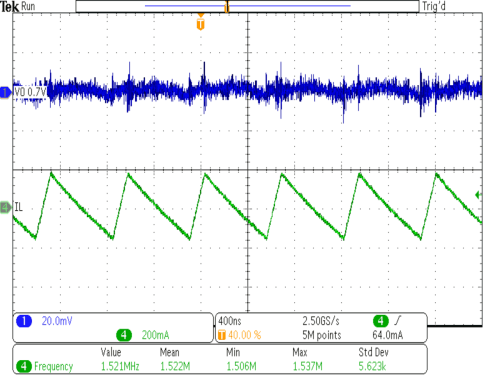
| VOUT = 0.7
V |
IOUT = 0
mA |
VSEL/MODE = VIN (after
start-up) |
| VIN = 3.8
V |
PFM
Mode, L = 1-µH DFE201610E |
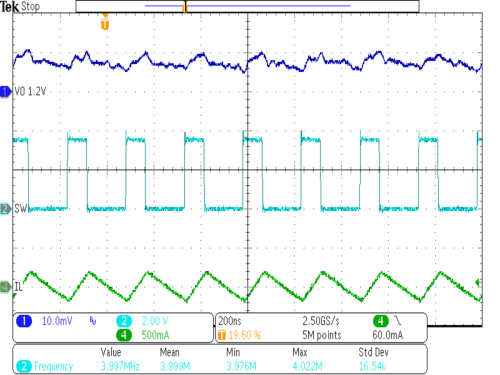
| Forced PWM mode |
VOUT = 1.2 V |
IOUT = 0 mA |
| VSEL/MODE = VIN (after start-up) |
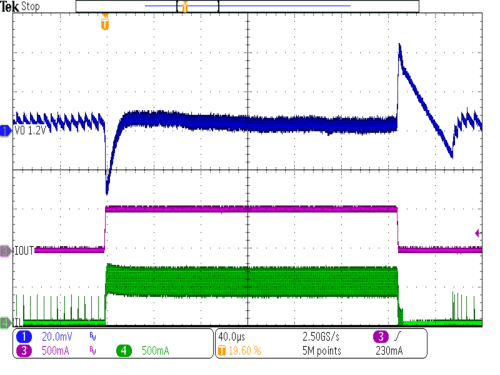
| TPS62801 |
VOUT = 1.2 V |
VSEL/MODE = GND |
| rise / fall time < 1 µs |
PFM /
PWM mode |
|
IOUT = 5 mA to 500 mA |
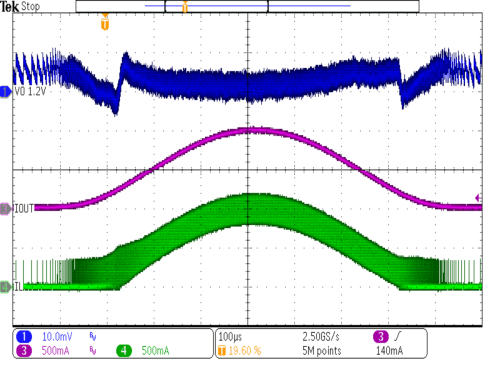
| TPS62801 | VOUT = 1.2 V | VSEL/MODE = GND |
| IOUT = 1 mA to 1 A 1 kHz | PFM/PWM mode |
| |
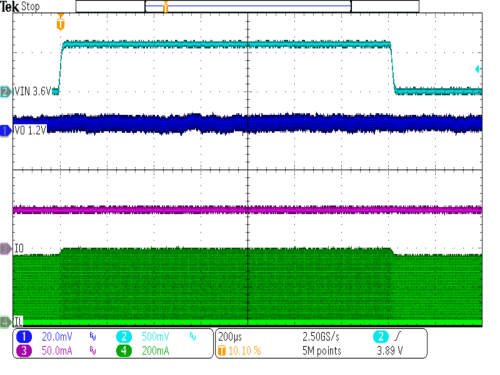
| TPS62801 | VOUT = 1.2 V | VIN = 3.6 V to 4.2 V |
| rise / fall time = 10 µs | IOUT = 50 mA |
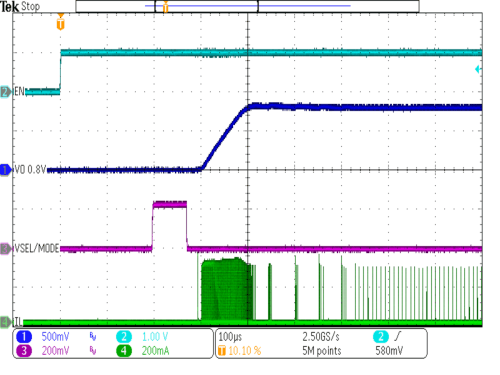
| VOUT = 0.8 V |
VSEL/MODE = Low (through RVSEL) |
| RVSEL = 10
kΩ |
RLoad = 220 Ω |
|
|
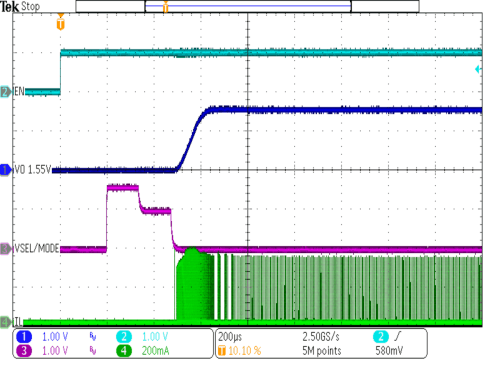
| VOUT = 1.55 V |
VSEL/MODE = Low (through RVSEL) |
| RLoad = 220
Ω |
RVSEL = 249 kΩ |
|
|
 Figure 9-42 Start-Up Delay Time, VSEL
= 0
Figure 9-42 Start-Up Delay Time, VSEL
= 0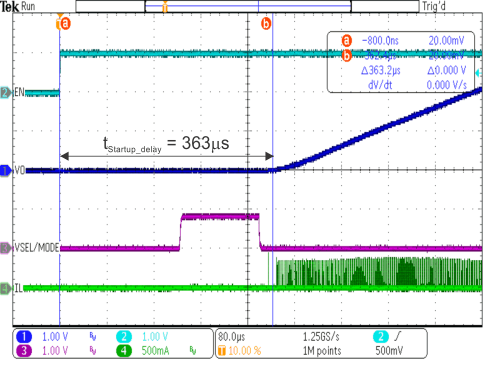 Figure 9-44 Start-Up Delay Time, VSEL
= 7
Figure 9-44 Start-Up Delay Time, VSEL
= 7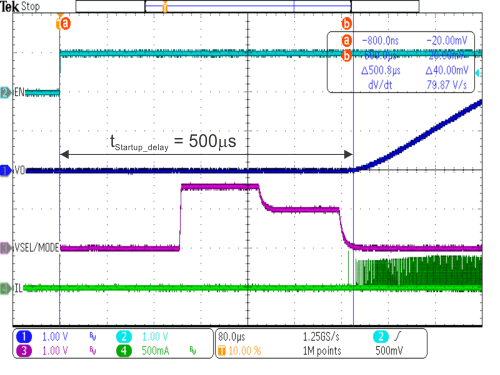 Figure 9-46 Start-Up Delay Time, VSEL
= 16
Figure 9-46 Start-Up Delay Time, VSEL
= 16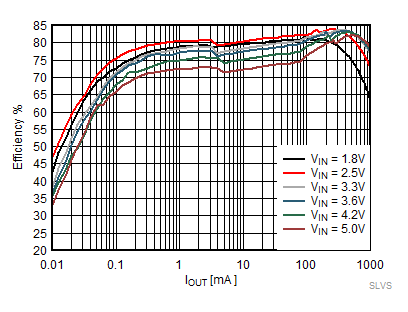 Figure 9-3 Efficiency Power Save
Mode
Figure 9-3 Efficiency Power Save
Mode
VOUT = 0.7 V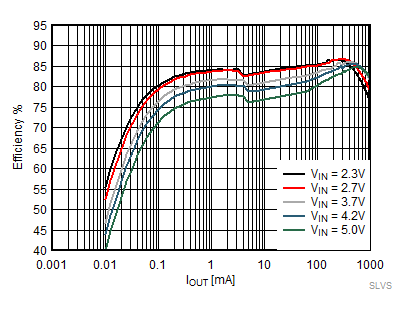
| TPS62801 | RVSEL = 15.4 kΩ to GND |
VOUT = 0.9 V Figure 9-7 Efficiency Power Save
Mode
Figure 9-7 Efficiency Power Save
Mode
VOUT = 1.2 V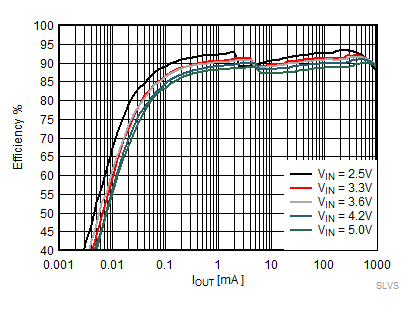 Figure 9-9 Efficiency Power Save Mode
Figure 9-9 Efficiency Power Save Mode
VOUT =
1.8 V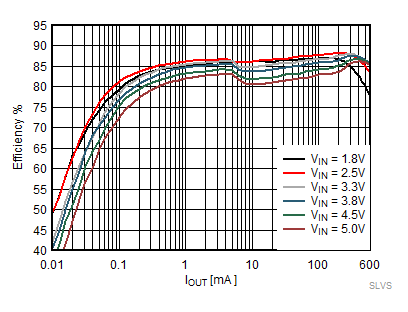
| TPS62806 |
VOUT = 0.7 V, VSEL/MODE = GND |
| L =
1-µH DFE201610E |
Figure 9-11 Efficiency Power Save Mode
VOUT = 0.7
V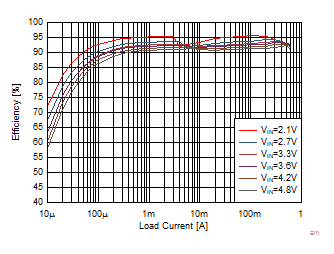
| TPS62808 | VOUT = 1.8 V, VSEL/MODE =
GND |
| L = 1-µH DFE201610E |
VOUT = 1.8 V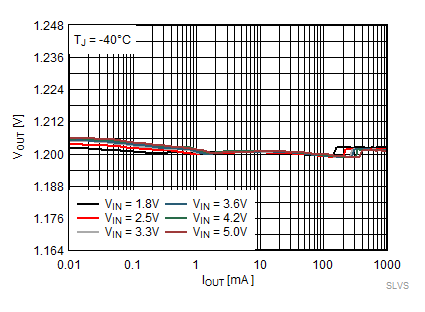
| TPS62801 | VSEL/MODE = GND |
| VOUT = 1.2 V | PFM/PWM mode | TJ = –40°C |
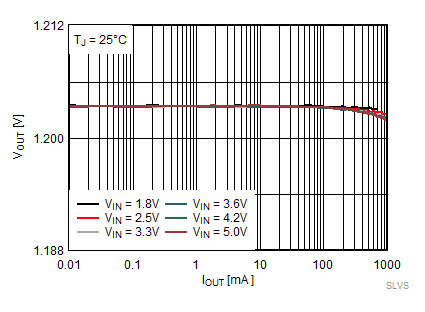
| TPS62801 | VSEL/MODE = high after start-up |
| VOUT = 1.2 V | Forced PWM mode | TJ = 25°C |

| TPS62801 | VSEL/MODE = high after start-up |
| VOUT = 1.2 V | Forced PWM mode | TJ = 85°C |
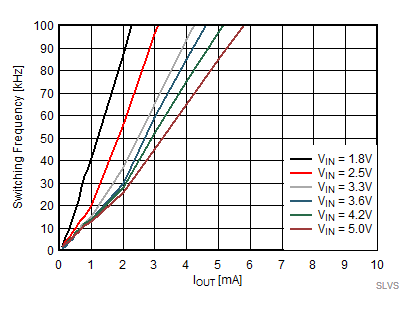
| TPS62801 | VSEL/MODE = GND |
| VOUT = 1.2 V | PFM/PWM mode | TJ = 25°C |
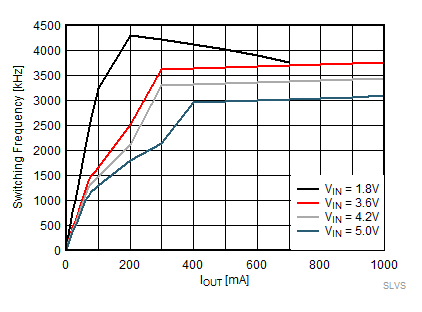
| TPS62801 | VSEL/MODE = 10 kΩ to GND |
| VOUT = 0.8 V | PFM/PWM mode | TJ = 25°C |
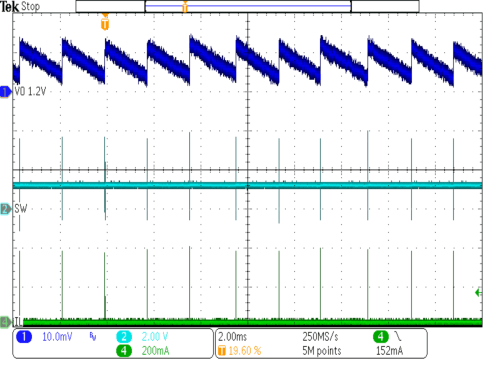
| TPS62801 |
VOUT = 1.2
V |
VSEL/MODE = GND |
|
IOUT = 25
µA |
PFM mode |

| VOUT = 0.7 V | IOUT = 10 mA | VSEL/MODE = GND |
| VIN = 3.8 V | PFM Mode, L = 1-µH DFE201610E |
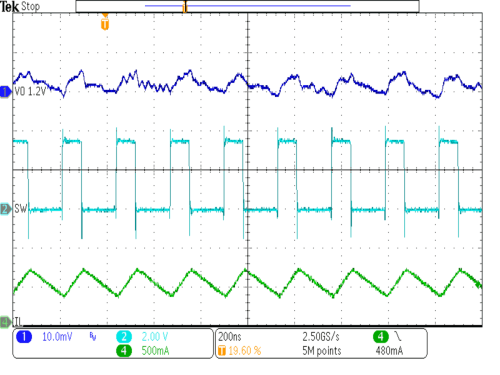
| PWM mode | VOUT = 1.2 V | VSEL/MODE = GND |
| IOUT = 500 mA |
| | |
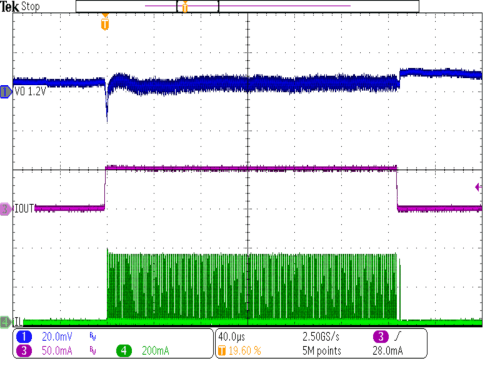
| TPS62801 |
VOUT = 1.2
V |
VSEL/MODE = GND |
| rise / fall time < 1
µs |
IOUT = 0 mA to 50 mA, PFM Mode |
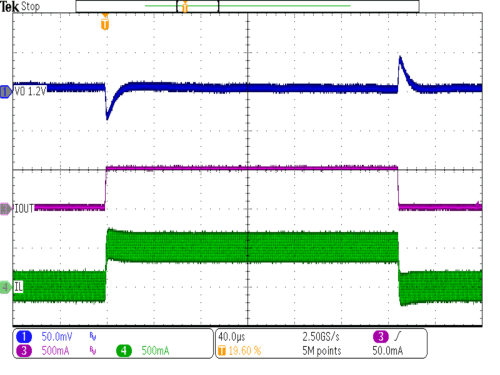
| Forced PWM mode |
VOUT = 1.2 V |
VSEL/MODE = VIN (after start-up) |
| rise / fall time < 1 µs |
IOUT = 5 mA to 500 mA |
|
|
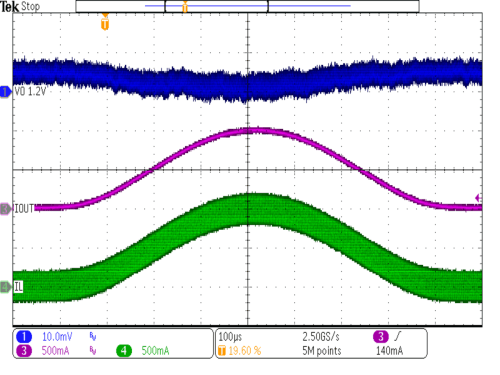
| TPS62801 | VOUT = 1.2 V | VSEL/MODE = VIN |
| IOUT = 1 mA to 1 A, 1 kHz | (after start-up) |
| Forced PWM mode |
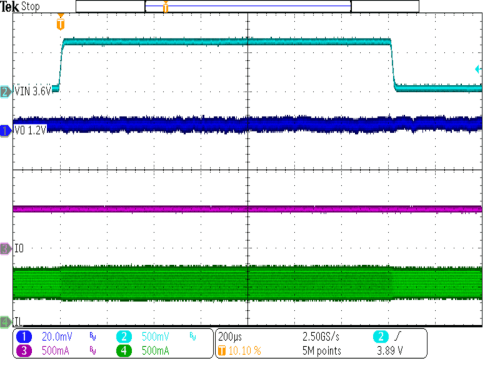
| TPS62801 | VOUT = 1.2 V | VIN = 3.6 V to 4.2 V |
| rise / fall time = 10 µs | IOUT = 500 mA |
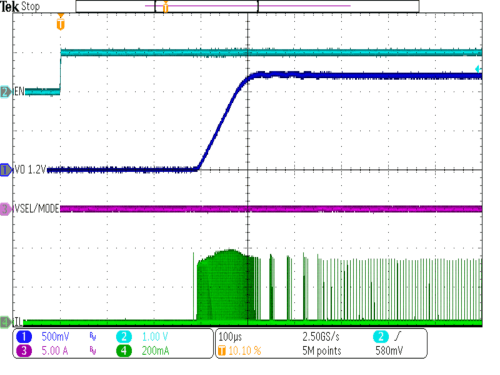
| TPS62801 | VOUT = 1.2 V | VSEL/MODE = GND |
| | RLoad = 220 Ω |
| | |
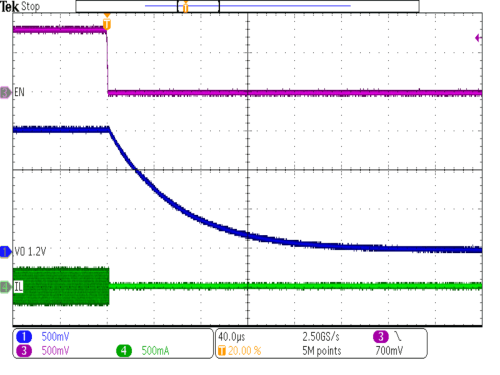
| TPS62801 | VOUT = 1.2 V | VSEL/MODE = VIN |
| EN = high to low | No load |
| | |
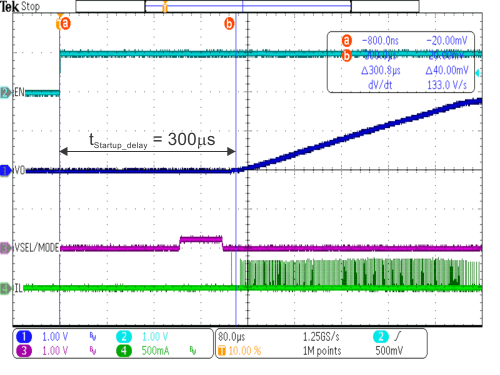 Figure 9-43 Start-Up Delay Time, VSEL
= 1
Figure 9-43 Start-Up Delay Time, VSEL
= 1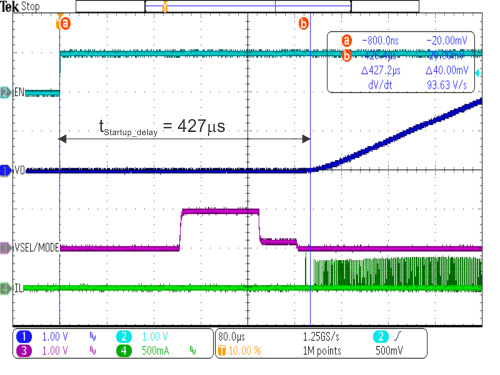 Figure 9-45 Start-Up Delay Time, VSEL
= 8
Figure 9-45 Start-Up Delay Time, VSEL
= 8











































